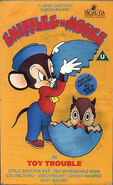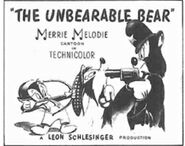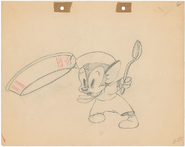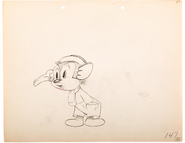The Unbearable Bear is a 1943 Merrie Melodies short directed by Charles M. Jones.
Plot[]
Sniffles' talkativeness foils both a burglar and a tipsy Officer Bear, who's trying to sneak past his rolling-pin-toting, sleepwalking wife.
Music-Cues[5][]
- I Want A Big Fat Mama (by Lucky Millinder)
- Plays during the opening credits[6]
- Blues in the Night (by Harold Arlen)
- Played during the first shot of Officer Bear's wife.
- Sidewalk Serenade (by Frank Weldon)
- Plays when Sniffles addresses the burglar.
- Frat (by John F. Barth)
- Played on the radio
- For He's a Jolly Good Fellow (traditional)
- Played when Officer Bear walks in drunk
- Good Night, Ladies (traditional)
- Played when Officer Bear goes to bed
- Blues in the Night (by Harold Arlen)
- Plays again when the Mama Bear starts sleep walking
- Sidewalk Serenade (by Frank Weldon)
- Plays again when Sniffles is talking to Fox a the clothes pin.
Availability[]
(1989) VHS
Sniffles the Mouse in Toy Trouble
Sniffles the Mouse in Toy Trouble
(1992) LaserDisc
The Golden Age of Looney Tunes, Vol. 2, Side 10: Variations on a Theme
The Golden Age of Looney Tunes, Vol. 2, Side 10: Variations on a Theme
(2012) DVD
Looney Tunes Mouse Chronicles: The Chuck Jones Collection, Disc 1
Looney Tunes Mouse Chronicles: The Chuck Jones Collection, Disc 1
(2012) Blu-ray
Looney Tunes Mouse Chronicles: The Chuck Jones Collection, Disc 1
Looney Tunes Mouse Chronicles: The Chuck Jones Collection, Disc 1
Goofs[]
- When the officer bear is talking to the burglar fox at gunpoint, the bear's eyes briefly turn green.
Notes[]
- This cartoon marked a new direction in the Sniffles cartoon series; it has a zanier, faster pace and more humorous direction than previous Sniffles cartoons, as director Chuck Jones "learned to be funny" starting with "The Dover Boys". Prior to that, Sniffles cartoons were cutesy and slow-moving in pacing, direction, and timing.
- This is the first cartoon where Marjorie Tarlton, who voiced Batty in "The Brave Little Bat", voiced Sniffles, taking over the role from Margaret Hill-Talbot.
- Starting from this cartoon, Sniffles has been recast as an incessant chatterbox who serves more as a nuisance than a cute protagonist, borrowing influences from Friz Freleng's discarded Little Blabbermouse character.
- The original titles had the song "Big Fat Mama" playing over them.[7]
- A cel of the original title card and a black-and-white photo of the same were posted on Facebook in 2021.
- This is the first Warner Bros. cartoon on which June Foray worked, although she would not become a permanent presence until 1955.
- Vitaphone release number: 995[8]
- As late as 2008, a 35mm print of this cartoon with original titles was known to exist.[9]
Gallery[]
Background color key by John McGrew
References[]
- ↑ https://www.facebook.com/photo/?fbid=10165808603900578&set=pb.619090577.-2207520000
- ↑ https://blueribbonblues.neocities.org/gallery
- ↑ Catalog of Copyright Entries
- ↑ http://likelylooneymostlymerrie.blogspot.com/2016/06/401-unbearable-bear-1943.html
- ↑ https://www.imdb.com/title/tt0036472/soundtrack/
- ↑ https://www.patreon.com/posts/whats-score-81644429
- ↑ https://cartoonresearch.com/index.php/more-lost-looney-tunes-title-cues/
- ↑ Liebman, Roy (2003). Vitaphone Films: A Catalogue of the Features and Shorts. McFarland, page 275. ISBN 978-0786412792.
- ↑ https://www.whataboutthad.com/2012/05/08/mice-is-nice/#comment-9737

















